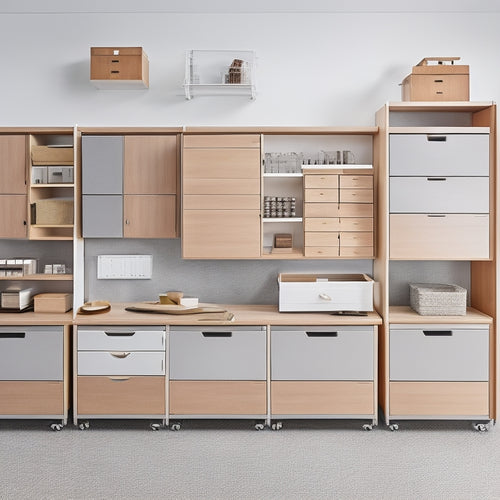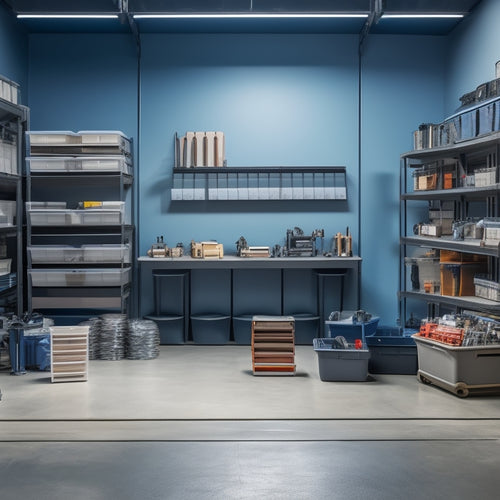
Boosting Productivity With Wood Shop Organization Ideas
Share
By implementing a well-thought-out organization system in your wood shop, you can greatly reduce wasted time searching for tools and materials, creating a more efficient and productive work environment that allows you to focus on the task at hand. Start by evaluating your workspace and workflow to identify primary activities and ideal layout. Then, designate specific areas for tools, materials, and tasks, and implement strategies for efficient storage and retrieval. As you enhance your workbench and workflow, you'll find that you're able to complete projects faster and with greater accuracy - and there's even more to investigate to take your productivity to the next level.
Key Takeaways
- Create a functional workspace by evaluating workflow, ensuring adequate lighting, and implementing acoustic treatment and seasonal organization.
- Implement tool storage and organization strategies, including designated areas, toolboxes, and color coding, to reduce tool searching time.
- Optimize workbench and workflow layout by positioning tools at a comfortable height, grouping similar tools, and ensuring sufficient workspace for projects.
- Establish task-oriented zones with designated work areas, tool clustering, and safety measures to streamline workflow and improve productivity.
- Implement a material tracking system, categorize materials, and utilize storage solutions to streamline material inventory and reduce waste.
Creating a Functional Workspace
To create a functional workspace in your wood shop, start by evaluating your workflow and identifying the primary activities you'll be performing. This will help you determine the best layout and allocation of resources.
Make sure your workspace lighting is adequate, with a mix of overhead lighting and task-specific lighting to reduce eye strain. Select a color scheme that promotes focus and calmness, such as blues and greens, and incorporate inspirational decor that motivates you to create.
Consider acoustic treatment to minimize echo and distractions. Organize your workspace seasonally, storing tools and materials that are only used during specific times of the year.
Prioritize workspace ergonomics by positioning your tools and workstation to minimize strain on your body. Integrate natural elements, like plants or a skylight, to enhance your mood and productivity.
Essential Tool Storage Strategies
One of the most essential aspects of a well-organized wood shop is having a solid tool storage strategy in place. This not only saves you time searching for tools but also reduces the risk of accidents caused by misplaced or unsecured tools.
You'll want to designate specific areas for different tool categories, such as hand tools, power tools, and accessories. Toolbox organization is critical, so consider investing in a high-quality toolbox with dividers and compartments. Label each section clearly, so you can quickly identify where a tool is stored.
For frequently used tools, consider portable storage options like tool chests or rolling cabinets. These allow you to keep essential tools within easy reach while keeping the floor clear of clutter. Additionally, store heavy or bulky tools near the floor to prevent them from falling and causing injury.
Optimizing Workbench Layout
You've spent hours perfecting your tool storage strategy, but now it's time to turn your attention to the heart of your wood shop: the workbench. Optimizing your workbench layout is essential for enhancing productivity and reducing fatigue.
Start by ensuring your workbench is at a comfortable height, allowing you to work with your arms at a 90-degree angle. This will reduce strain on your back and shoulders.
Next, consider tool accessibility. Place frequently used tools within easy reach to minimize walking distances and reduce the risk of accidents. Install a pegboard or a tool holder on the wall or on the workbench itself to keep tools organized and easily accessible.
Group similar tools together, such as all measuring tools in one area, to streamline your workflow. Additionally, leave enough space on your workbench for your projects, considering the size and shape of your typical projects.
Streamlining Material Inventory
A well-organized material inventory is crucial to maintaining a smooth workflow in your wood shop. You'll avoid wasting time searching for specific materials, reduce the risk of accidents caused by clutter, and guarantee you have the necessary supplies to complete projects efficiently.
To achieve this, implement a material tracking system that accounts for all your materials, including lumber, hardware, and finishing supplies. Categorize materials based on type, size, and frequency of use, and assign a designated storage space for each category.
Employ storage solutions like bins, baskets, and shelves to keep materials off the floor and within easy reach. Effective inventory management also involves regularly checking stock levels and replenishing supplies as needed.
This guarantees you allocate resources efficiently and avoid overstocking or running out of critical materials mid-project. By streamlining your material inventory, you'll be better equipped to tackle projects with confidence, knowing you have the right materials at your fingertips.
Implementing Task-Oriented Zones
You'll maximize efficiency in your wood shop by creating designated work areas for specific tasks, such as a sanding station or a finishing area.
By clustering tools and equipment into stations, you'll reduce walking distances and minimize switching between tasks.
Designated Work Areas
Within the confines of your wood shop, implementing task-oriented zones enables you to efficiently allocate space and resources, streamlining your workflow and reducing downtime. By designating specific areas for tasks like material preparation, assembly, and finishing, you'll optimize your work flow and minimize travel time between tasks.
When designing your layout, consider safety measures like access points and emergency exit routes. Guarantee adequate space allocation for material handling and equipment placement, taking into account the size and mobility of your machines.
Lighting options should be customized to each zone, with brighter lights for tasks requiring precision and softer lighting for areas where workers will be standing for extended periods. Noise control measures, such as sound-absorbing materials or noise-cancelling headphones, should also be integrated into your design.
To further enhance efficiency, consider incorporating mobile stations that can be easily moved between zones. This will enable you to adapt to changing project requirements and reduce the risk of workpiece damage during transport.
Tool Station Clusters
Your tool station clusters should be strategically positioned throughout the wood shop to maximize efficiency and minimize travel time between tasks. This is achieved by grouping tools based on their function and the tasks they're used for, creating a cluster organization that streamlines your workflow.
By doing so, you'll enhance station efficiency, making it easier to access the tools you need when you need them. Modular stations are ideal for tool station clusters, as they can be easily rearranged or added to as your needs change. This flexibility allows you to prioritize tasks and allocate tools accordingly.
Tool visibility is also vital, ensuring that you can quickly identify the tools you need and retrieve them with ease. Proper tool grouping and cluster organization also improve workspace accessibility, reducing the risk of accidents and injuries.
Workflow Segmentation
By organizing your wood shop into distinct task-oriented zones, you can further optimize your workflow and reduce downtime.
This workflow segmentation approach enables you to allocate specific areas for specific tasks, streamlining your work process and minimizing the time spent moving between tasks.
To maximize workflow efficiency, consider dividing your wood shop into the following zones:
-
Material preparation zone: dedicated to cutting, sanding, and preparing materials for projects.
-
Assembly zone: where you'll assemble and construct projects, with easy access to necessary tools and materials.
-
Finishing zone: designed for applying finishes, stains, and coatings, with proper ventilation and safety measures.
- Quality control zone: a designated area for inspecting and testing finished projects, ensuring they meet your quality standards.
Effective Dust Collection Systems
Frequently, woodworkers overlook the importance of effective dust collection systems, treating them as an afterthought rather than an integral part of their workshop setup. This oversight can lead to poor air quality, reduced visibility, and even health hazards.
To avoid these issues, you should prioritize dust extraction techniques and air quality management in your wood shop.
When designing your dust collection system, consider the CFM (cubic feet per minute) requirements of your tools and the size of your workspace. A general rule of thumb is to have a minimum of 1,000 CFM for every 1,000 square feet of workspace.
You'll also need to choose the right dust collector for your needs, considering factors like filter type, motor power, and noise level.
Properly installing and maintaining your dust collection system is essential. Make certain that all ducts and hoses are securely connected, and that the system is regularly cleaned and inspected.
Maximizing Vertical Storage Space
In a wood shop where every inch counts, maximizing vertical storage space is essential to maintaining a clutter-free and organized workspace. This allows you to focus on your projects without wasting time searching for tools or materials.
To get started, consider the following vertical storage solutions:
-
Wall mounted racks and pegboard panels for hanging tools and accessories within easy reach.
-
Vertical bins and stackable bins for storing materials and supplies, keeping them off the floor and out of the way.
-
Ceiling storage and hanging shelves for infrequently used items or seasonal decorations.
- Ladder storage and magnetic strips for keeping frequently used items, like clamps and tapes, within easy reach.
Additionally, adjustable shelving, tool carts, and foldable tables can be used to create flexible workstations.
Corner shelves, over the door storage, and wall hooks can also be used to maximize storage in tight spaces.
Simplifying Cord Management
As you optimize your wood shop's vertical storage space, you're likely to uncover a tangled mess of cords and cables that can hinder your workflow. Simplifying cord management is essential to enhance productivity and guarantee safety. A well-organized cord system prevents tripping hazards, reduces wear and tear on cables, and saves time searching for specific cords.
To achieve effective cord organization, consider the following strategies:
| Cord Organization Method | Description | Benefits |
|---|---|---|
| Cable Ties | Use reusable cable ties to bundle cords together | Easy to install, reduces clutter |
| Cord Reels | Store cords on reels to prevent tangles | Saves space, reduces cord damage |
| Cable Management Boxes | Organize cords in labeled boxes for easy access | Improves workflow, reduces search time |
Designing an Ergonomic Workflow
Most woodworkers spend a significant amount of time standing, bending, and moving around their workshops, which can lead to fatigue, discomfort, and even injuries if their workflow isn't properly designed.
To avoid these issues, you need to design an ergonomic workflow that minimizes strain on your body. This involves arranging your workspace to reduce bending, stretching, and walking distances.
Here are some key considerations:
-
Position heavy tools and equipment at waist level to reduce lifting and bending.
-
Group similar tasks together to minimize walking distances and optimize workspace flow.
-
Invest in ergonomic tools, such as adjustable height tables and anti-fatigue mats, to reduce strain on your body.
- Create a "work zone" around each workstation, keeping frequently used tools and materials within easy reach.
Maintaining a Clutter-Free Environment
You'll save time and reduce stress by maintaining a clutter-free environment in your wood shop.
To achieve this, you'll need to clear your workspace daily, removing any tools or materials that aren't in use.
Clear the Workspace Daily
Clearing the workspace daily is essential to maintaining a clutter-free environment in your wood shop. This habit helps prevent accidents, reduces stress, and saves time in the long run.
By incorporating daily routines into your workspace habits, you'll guarantee a safe and organized working area.
Here are 4 key steps to follow:
-
Put away tools and materials: After completing a project, return all tools and materials to their designated storage spaces. This prevents clutter from building up and makes it easier to find what you need for your next project.
-
Sweep and clean the floor: Remove any debris, shavings, or dust from the floor to prevent slips and falls. This also helps prevent damage to your equipment and tools.
-
Wipe down surfaces: Clean any workbenches, tables, or machinery to remove dirt, oil, or other substances that can affect future projects.
- Inspect your workspace: Take a few minutes to inspect your workspace for any hazards or areas that need improvement. This helps you identify potential safety risks and make adjustments as needed.
Label and Categorize Tools
A well-organized tool collection is the backbone of a clutter-free wood shop. To achieve this, you'll need to implement effective tool identification methods. One approach is to use a color coding system, where tools are categorized by function or type and assigned a specific color. For instance, you can use red labels for power tools, blue for hand tools, and green for measuring instruments. This visual system allows you to quickly identify tools and prevent mix-ups.
Labeling tools also helps prevent loss or misplacement. You can use labels or stickers with the tool's name, its assigned location, and any relevant safety information. Consider using a standardized labeling format to guarantee consistency throughout your shop.
Additionally, categorize tools by their frequency of use, storing the most frequently used tools in easy-to-access locations. This will save you time and reduce frustration when searching for a specific tool.
Designate Storage Areas
Every wood shop has its unique storage challenges, but designating specific areas for different types of items is essential to maintaining a clutter-free environment. This helps prevent accidents, saves time, and increases productivity.
By designating storage areas, you'll be able to quickly locate the items you need, reducing the risk of injury from tripping or falling over clutter.
To get started, consider the following storage solutions:
-
Tool cribs: Designate a specific area for frequently used hand tools, such as hammers, screwdrivers, and pliers.
-
Material storage racks: Use racks or shelves to store lumber, plywood, and other materials, keeping them organized and easily accessible.
-
Supply bins: Label and organize bins for storing small items like fasteners, adhesives, and finishing supplies.
- Equipment stations: Designate specific areas for larger equipment, such as table saws, drill presses, and sanders, ensuring they're safely stored and easily accessible.
Frequently Asked Questions
How Do I Deal With Limited Floor Space in My Wood Shop?
When dealing with limited floor space, you'll want to maximize vertical storage by installing shelves and cabinets, and consider investing in mobile workstations that can be easily rearranged to accommodate different projects and tasks.
Can I Use Pegboards for Storing Small Hand Tools and Accessories?
Like Hercules taming the Hydra, you can conquer clutter by utilizing pegboards for storing small hand tools and accessories, optimizing pegboard layouts for swift tool accessibility, ensuring a safe and efficient workspace that's a cut above the rest.
Are There Any Benefits to Using Clear Storage Bins and Containers?
When storing small items, you'll appreciate using clear storage bins and containers, as they provide clear visibility, allowing you to quickly identify contents, and grant easy access, reducing the risk of accidents caused by digging through cluttered shelves.
How Often Should I Clean and Maintain My Wood Shop Equipment?
You should clean and maintain your wood shop equipment regularly to guarantee equipment longevity; establish a routine maintenance schedule, ideally weekly, to inspect and address any issues, preventing damage and guaranteeing a safe working environment.
Can I Repurpose Old Furniture to Create Custom Wood Shop Storage Solutions?
You can breathe new life into old furniture by repurposing it into custom storage solutions, converting discarded pieces into functional, space-saving gems that optimize your workshop's efficiency, ensuring a safer, more organized environment that sparks creative freedom.
Conclusion
By implementing these wood shop organization ideas, you'll be astonished at how much more productive you can be. Did you know that, on average, a woodworker spends around 30 minutes per day searching for misplaced tools and materials? By streamlining your workspace, you can reclaim that time and focus on what really matters - creating something extraordinary. With a well-organized wood shop, you'll be able to work more efficiently, reduce stress, and take your projects to the next level.
Related Posts
-

Modular Tool Storage Systems for Small Spaces
You can optimize your small workspace by leveraging modular tool storage systems that intelligently employ vertical s...
-

Small Storage Bins to Maximize Shelf Space
When maximizing shelf space, you want to make the most of every inch. Small storage bins are the answer, but choosing...
-

How to Maximize Storage Space With Parts Storage Bins
To maximize storage space with parts storage bins, start by evaluating your available storage space and examining you...


